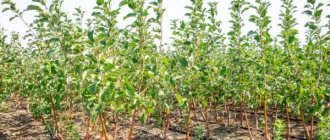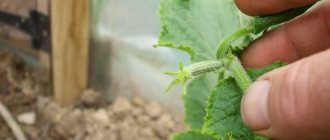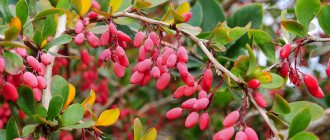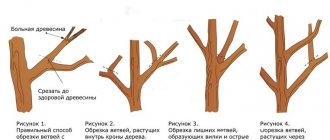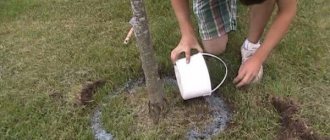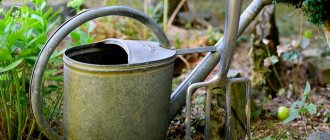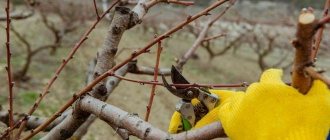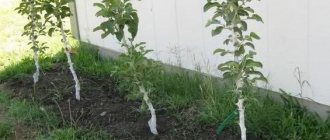Typically, gardeners rarely replant an adult tree. This is a very important procedure that allows the plant to properly adapt and develop in a new place. If you carry it out regularly, you can ruin the apple tree, since mature trees are not touched unless absolutely necessary. With proper movement, productivity indicators improve and the growth of new shoots is activated. After transplantation, the crop is fertilized with various preparations. If you follow all the rules for care and fertilization, then next year the plant will begin to grow and produce a healthy and abundant harvest.
Why are apple trees replanted?
Large apple trees are transplanted to another location for the following reasons:
- the place is not suitable for the development of culture due to lack of light, poor soil, and drafts;
- damage or thinning of the place where the trunk meets the roots;
- lack of space;
- infection with diseases.
In order for a tree to take root in a new place, it is necessary to create favorable conditions. Trees that are no more than 15 years old are subject to transplantation. After this period, there is no point in carrying out the procedure, since the likelihood of survival is very low.
What to do if the roots are damaged
The survival rate of an apple tree depends on the condition of the root system.
If the main rods are healthy, then the second-order roots extending from them quickly regenerate. Therefore, after removing it from the soil, the injured roots are removed, and a garden varnish and an antiseptic drug are applied to the cuts.
If one of the leading rods that conduct nutrients to the trunk is injured, then the damaged area is treated with an antiseptic and covered with varnish.
In order for the root to recover faster, the branches are pruned - this increases the chance of its survival.
Criteria for choosing a landing site
Before replanting an apple tree, you need to choose the best place with good soil:
- You need to choose a piece of land where surface groundwater does not pass close.
- The area should be well lit and warmed by the sun, and also protected from draft winds.
- Fruit trees and powerful shrubs should not be planted nearby.
- Loamy soil is ideal. Ground with gravel and crushed stone can cause the death of the tree. Clay, peaty and sandy soil is not suitable.
Under these conditions, the tree will grow stronger faster and begin to bear fruit. If one of the conditions does not meet, it is necessary to apply fertilizer and drain the soil.
A 5-year-old apple tree already has a large root system and crown, so it will not be possible to cope with the transplant alone. To pull out the roots with a lump of earth, use a crowbar or a wide wooden board. The roots that will extend beyond the earthen ball are cut off. To hold the trunk in a new place, four supporting pegs are installed.
Seedling preparation
When deciding when to transplant a plant, you need to choose a time when the planting is dormant. It is better to start the procedure in early spring. Before planting, the plant must be inspected for the presence of diseases and pests. There should be no damage to the trunk or branches. The apple tree should not show signs of rot.
Before planting, the roots of the tree are placed in a basin of water. Recommended time: 2 days.
It is better to replant the plantings at the age of 2 years. The tree is dug up along with a lump of earth according to the diameter of the crown. It will be easier to pull out the seedling if the circle around the trunk has been previously watered abundantly.
When should you replant a tree?
To start replanting, it is better to wait until the apple tree is at rest. The stage coincides with early spring or late autumn. Transplanting an adult tree is also possible in winter, but only if the air temperature does not drop below -5 degrees.
If the air is very dry with low temperatures, then it is better to postpone the transplantation process to spring. If the soil on the site is depleted, then it is better to replant in the fall.
The procedure is carried out only in the evening, since plants complete photosynthesis processes during this period.
in spring
The spring period for replanting is suitable for those areas that are not rich in minerals and other useful substances. In the spring, the crop is transplanted until the buds begin to bloom.
in autumn
Experienced experts advise replanting an apple tree of any age in the fall. During this period of time, the culture prepares for the winter cold, so it becomes less sensitive to various influences, and resistance to stress increases.
In the fall, they begin to work only after the leaves have completely fallen, but you need to try to do it before the onset of cold weather. The roots of the transplanted tree should adapt to the new location; there should be no frost for another month.
If there is no time to wait until the leaves fall, then they are cut off. This is necessary so that the apple tree saves energy for adaptation.
In summer
The best time for transplantation is considered to be the autumn or spring months. Summer is the best time for fertilizing or grafting. If there is a need for a summer transplant, the following recommendations will come in handy:
- Winter-hardy varieties of apple trees are most suitable for replanting;
- an apple tree transplanted in summer requires additional feeding and watering;
- Be sure to mulch the soil around the trunk;
- It is advisable to remove most of the leaves;
- the foliage should be healthy and the branches free of damage.
See also
How to feed a young and adult apple tree in spring, summer and autumn during ripening and fruitingRead
The most suitable time is the beginning of July. A cloudy, windless day is suitable for replanting, or evening hours are chosen for work.
Landing dates
Gardeners often argue when it is better to replant an apple tree - in spring or autumn. We have to admit that the best time for transplantation is autumn. After moving, the tree needs to take root and gain strength. If transplantation is done in the spring, the apple tree has to spend energy on the growing season.
When is the best time to replant an apple tree in the spring:
- if the soil is non-chernozem;
- if it was dry and cold in the fall.
If you decide to replant the apple tree in the spring, you need to choose cloudy weather. Bright sun is contraindicated for a transplanted tree.
In summer, replanting fruit trees is strictly prohibited. In winter, only mature apple trees can be replanted. But the temperature should not be less than +5°C.
Preparatory work
A hole is dug in the new area. If the transplant is carried out in the fall, then the deepening is done 4 weeks before the intended procedure. For transplantation in the spring season, the pit is prepared in the autumn.
All damaged branches and roots are removed from the tree that is to be replanted. Parts of the root system that are too long should also be trimmed.
Necessary tool
The following equipment will be useful for work:
- garden shovel and pitchfork;
- metal or wooden stakes;
- strong ropes;
- thick fabric or bag;
- garden shears for cutting branches.
Replanting a mature tree will require several people.
Preparing the tree and transplant site
In order not to damage the culture, it is necessary to prepare for the transplantation procedure:
- The branches on the tree must first be trimmed. If this is not done, then in the future there is a high risk of drying out of the shoots. The procedure helps improve immunity. The pruning length is determined by the age of the apple tree.
- Be sure to remove dry, damaged branches. The cut site is treated with a special healing agent.
Before digging up a mature tree, you need to prepare a hole for planting in a new area. The hole is usually dug a couple of weeks before transplanting. It should be one third deeper than the earthen lump. In apple trees at the age of 10 years, the width of the earthen coma is 1.5 meters, at the age of 11 to 15 years - 2 meters.
A small layer of soil is placed at the bottom of the hole, which will settle within a month and will not pull the roots down. Then fertilizers are added to the hole. A composition of manure, river sand, compost and sawdust is suitable.
If there is groundwater close to the surface of the earth, then you first need to make a drainage 1.5 meters high (a crushed stone drainage is installed at the bottom of the hole). Only after this they begin to dig a hole.
How to replant a mature tree
In gardening, situations often arise that require replanting a mature apple tree. However, before this, it is important to make sure that the procedure is really necessary and cannot be avoided. Transplantation is possible if the tree is at least fifteen years old. When the rootstock is dwarf, the period increases.
In order for the manipulation to proceed safely and without complications, it is necessary to preserve the integrity of the entire root system and branches. The roots should not be allowed to dry out. You can increase the chances of engraftment by properly trimming the crown, which will prevent the branches and bark from drying out. In addition, the apple tree needs to be provided with proper care, quality soil and nutrition.
By following the proposed rules and recommendations, you will replant the tree without any problems, and the apple tree will delight you with a generous, high-quality harvest.
Tree replanting process
You need to replant a tree correctly:
- the apple tree is dug up along with a lump of earth;
- the apple tree is pryed up with a wooden board or crowbar;
- Having fixed the crown and roots, the crop is moved to the planting hole.
Stakes are driven in around the planted tree, humus is added in mid-October, the soil is mulched and the trunk is tied up.
During planting, you need to keep the same orientation of the tree as in the old place, so a mark is made on the trunk. The branches should be turned in the same direction as before transplantation.
Digging technology
To avoid damaging all parts of the tree, it is necessary to dig it out correctly:
- Young and mature trees are dug up together with a lump of earth. First, the soil around the trunk needs to be thoroughly watered to make it easier to pull out the roots.
- The tree is inspected before planting. Rotten roots and dry branches are cut off. Young seedlings are left in a basin of water for several days.
- It is recommended to make a mark on the trunk in the place where it begins to be visible from the ground. This will allow the tree to be positioned correctly in the new hole.
The diameter and depth of digging the root system depends on the age of the tree. To prevent damage to it, they begin to dig at a great distance from the trunk.
Transportation rules
Transportation features depend on the distance the apple tree needs to be moved. You need to dig up the apple tree carefully, trying not to damage the roots.
If the distance is small, then the dug up tree is placed on thick fabric, and then dragged to the desired location.
If it is intended to move over a long distance, then the crown is tied up with thick ropes, and the earthen ball is wrapped in dense material. In this form they are dragged to a new site.
Landing at a new place
When transplanting apple trees, a number of rules are followed:
- trees that are more than 15 years old should not be touched;
- Trees with a broken trunk cannot be replanted;
- in the fall the crop is replanted, leaving it without leaves and fruits;
- a tree transplanted in the fall is insulated and mulched;
- The first year it is necessary to prune the branches, controlling growth.
See also
How can you mulch an apple tree, organic and inorganic materials, mown grassRead
Features of planting an apple tree in a new place depend on its age:
- It is easiest to replant an annual tree, as it is less susceptible to damage and quickly gets used to the new location. The best time for digging is considered to be the end of September. After digging, the root is shortened by a third. This promotes the emergence of new root branches that will better absorb moisture and nutritional components. It is better to replant in early spring.
- An apple tree takes root well in a new place at the age of 2 to 3 years. Seedlings are planted in prepared holes along with a clod of earth and a peg is installed nearby, to which the trunk is tied.
- An adult tree at the age of 4-5 years is planted in the same way as a young one, but it has its own characteristics. Do not replant in spring. You should choose a wide board that will serve as a lever when extracting the roots from the ground. Then the trunk is fixed with pegs.
- Trees older than 5 years are replanted according to the same rules as young ones. It is better to replant in the spring. After transplantation, be sure to prune.
If you fulfill all the requirements and follow all the recommendations, the process will not be traumatic for the garden crop.
Transplanting seedlings in autumn
Apple tree seedlings in the fall, like older trees, begin to be planted after the leaves fall and before the ground freezes. By this time, their wood has matured and the tree is ready to withstand the conditions of the cold season.
A dug up seedling with unfallen leaves will have another problem. It will most likely turn out to be overdried, since it is through the leaves that moisture evaporates.
If there is a need to plant just such an apple tree, then you need to tear off all the leaves on it.
It is necessary to tear off all the leaves on the transplanted seedling.
If it is necessary to store the seedling, its roots are placed in a waterproof bag, to which wet sawdust, sphagnum moss or peat are added. Such measures are not suitable for long-term storage and then it is better to bury the seedling.
The hole for planting a seedling must be prepared in advance by filling its lower part with a mixture of fertile soil selected from the very top when digging the hole, compost, and peat. Potassium-phosphorus fertilizers are also added. And nitrogen fertilizers are applied in the spring.
A hole measuring 0.5 x 0.5 x 0.5 m is quite suitable for a seedling.
Watch a video about transplanting apple tree seedlings in the fall:
An important question is the depth of planting of the apple tree.
It is necessary to plant it at the same level as in the nursery where it grew. Its root collar should be at ground level, but given that the soil then settles, it is placed 3-5 cm higher. Otherwise, the deepening of the root collar will affect its development and fruiting.
Important! When planting a tree, you need to make sure that the roots do not curl up.
This must also be done if it has rained and the soil is wet.
Features of transplanting various types of apple trees
Basically, all types and varieties of apple trees are replanted according to the same scheme. There are minor differences in the course and choice of place for transplantation. Columnar apple trees are easiest to transplant.
Columnar
The columnar apple tree is replanted in the same way as other types of this crop. The main thing is not to damage the root branches and leave as much soil on them as possible. The best time is considered to be the first ten days of April. The root system of this type of crop is compact and superficial, so the transplantation procedure is easier.
Columnar apple trees do not develop well if there is excess moisture in the soil, so a drainage layer is placed at the bottom of the hole. Since the root system is shallow, a thick layer of mulch is required.
Dwarf
Dwarf apple trees grow in both well-lit and shady areas. The distance between seedlings should be 3 meters. The width of the hole being dug is 58 cm.
The transplant takes place according to standard rules. After replanting, the soil around the trunk is trampled down and mulched. A depression is made for irrigation within a radius of 65 cm from the trunk.
Dichka
Wild apple trees take root well in the spring, so replanting is carried out in late March. For a new place in the garden, choose an area that is as close as possible to the conditions of the previous growth. We are talking about the composition of the soil, the orientation of tree branches.
Features of planting different varieties
You may be interested in: When apple trees bloom in Kolomensky Park in 2021 How to properly plant an apple tree: timing, methods, features and care Why scab appears on apple trees and how to get rid of it
Having found out whether it is possible to replant an apple tree in the spring, you need to take into account all the nuances, including the plant variety:
- the columnar apple tree is moved at the end of April and a large layer of mulch is made, because the root system of the apple tree is superficial;
- a dwarf plant requires maintaining a distance of 3 meters from other trees;
- the wild plant is replanted in early March.
These are the only requirements that depend on the variety chosen.
Transplanting an apple tree is not difficult. The main thing is to follow all recommendations. Then the tree will easily take root and produce a harvest.
Caring for the tree after transplantation
The transplanted apple tree needs to be provided with great attention and care. Therefore, the following tips will come in handy:
- For the first time after transplanting, the tree is watered once a week;
- the first year after transplantation there is no need to dig up the soil near the trunk;
- in autumn the soil is mulched with humus or peat;
- the trunk is tied with warm covering material;
- in the spring, renewing pruning of branches is done;
- in the first year you need to remove all the color from the trees;
- Weeds must be removed.
A transplanted tree requires more care; it is imperative to protect the crop from frost, disease and rodents.
Regional features
The timing and method are determined by the climatic and soil conditions in the region where the garden plot is located.
Moscow region
Dates: September-October. The soil temperature should not be below 8°C.
Gardeners living in the Moscow region take into account the depth of groundwater.
- If the distance between groundwater and the soil surface is significant, then the tree can be transplanted to any place.
- If it is less than 1.5 m, and there are no hills on the site, then a hill must be built at the planting site.
Time to settle in a new place
The establishment of a transplanted tree in a new location is a long process. The survival time is affected by the age of the tree and compliance with care conditions. The younger the apple tree that was transplanted, the faster it will adapt to the new location and begin to bear fruit.
There are several reasons why the transplanted apple tree did not take root:
- purchasing an unsuitable seedling (for example, sick, weak or grown in the wrong conditions);
- excessive pruning of the root system before planting;
- inappropriate width and depth of the planting hole;
- excessive deepening of the root collar;
- planting in an area where groundwater flows too close;
- waterlogging of the soil (heavy rains or improper watering);
- planting an apple tree near other fruit bushes and trees;
- incorrect or untimely pruning;
- The transplanted tree was planted in a place where another tree had already grown.
If we take all these points into account, the time it takes for the apple tree to adapt to a new place is reduced.
When is the best time to plant an apple tree in spring?
Apple trees, like other fruit trees, can be planted in autumn and spring. The main disadvantage of autumn planting is the need to complete the procedure at least a month before frost. It is more advisable to plant in the spring: the soil has already warmed up, and the plants recover more easily. Many years of experience of gardeners shows that in central Russia, spring planting of apple trees is more effective than autumn planting.
The timing of spring planting differs depending on climatic conditions; in general, this is the period from late March to early May. Apple trees need to be planted before the buds begin to bloom. In most regions this period occurs at the beginning of April.
Seedlings with a closed root system can be planted later than usual
To determine the optimal planting time, you need to monitor the air temperature. The apple tree can be planted when the temperature is reliably above zero.
It is not necessary to wait for the soil to completely thaw - there is a risk of missing the beginning of the “awakening” of the apple tree, and then its adaptation will be long and difficult.
It is advisable to check the soil moisture before planting: if the soil can be dug up without effort, then the right time has come. Trees take root better in soil saturated with moisture, so additional watering is necessary when planting in late spring (early May), as well as in regions with early drought.
Selection of transplant material
The tree must be properly prepared for replanting:
- Dig in cloudy weather;
- The soil on the roots is not shaken off;
- As the root system is excavated, it must be protected from drying out. Therefore, as soon as they are freed, they wrap the roots with damp moss, burlap and other available material;
- It is advisable to plant immediately by cutting off the ends of the roots. The main root is cut by a third. This stimulates the appearance of additional roots;
- The crown is also trimmed a little. This reduces the evaporation of moisture from the leaf blades. All wounds with a diameter of 1 cm or more are covered with garden varnish or oil paint;
- Trees are dug up so that the area of their roots is at least half the area of the crown. It is better to replant with a clod of earth, but on personal plots this is difficult to do. Therefore, you have to move the apple tree to another growing location without a coma.
This link will tell you about Schnitt varieties.
The transplanted apple trees should not have any mechanical damage or open wounds, and you should not replant a tree with small growth.
How to transport
It is advisable to immediately transplant an old tree to a permanent place. But it may happen that the tree will have to be transported over some distance. In this case, it is necessary to protect its roots from drying out:
- Cover the root system with damp burlap;
- Place the lump in a bag, tying it;
- Place a piece of tarpaulin or plastic on the ground. Dig up the tree and place it in the center of the cut. Bring the edges of the material up and tie. Carefully place on the transport vehicle, securing it carefully;
- Place the tree in a bag and pour sawdust into it. Then the roots and the trunk itself will not be damaged.
